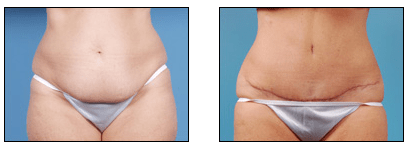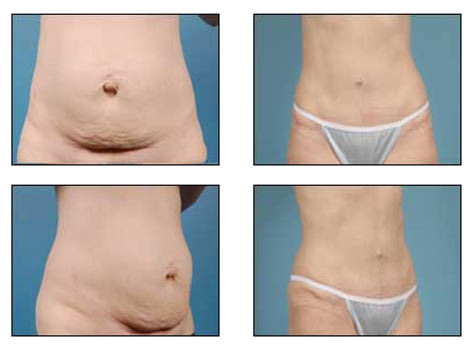Abdominoplasty for Excess Skin, Scarred Skin, and Mild Rectus Diastasis
Gregory Dumanian, M.D., offers tummy tucks in Chicago for patients who have lost skin elasticity due to major weight loss, pregnancy, heredity, or other reasons.
Why Choose Dr. Dumanian
Gregory Dumanian, M.D. is a specialist because of his extensive expertise and knowledge of the trunk developed from thousands of similar surgeries, both cosmetic and reconstructive. He has lectured to both plastic surgeons and general surgeons on abdominal wall issues in the United States and in Europe.
It is only the surgeon who performs both the cosmetic surgery of the skin and the functional surgery of the abdominal wall who can achieve the best results. Ask Dr. Dumanian for access on his website to the dozens of medical articles and book chapters that he has written on abdominal wall surgery. His most recent article in 2015 was on his new technique of “mesh abdominoplasty” for the most severe cases of rectus diastasis in both women and men.

The following are some commonly asked questions around abdominoplasty to better inform anyone considering this procedure with Dr. Dumanian.
Can Anyone Have An Abdominoplasty?
No. Tummy tuck surgery may not be for everyone. For instance, abdominoplasty is not a plastic surgery procedure designed for very heavy patients. Suitable candidates should be near their ideal body weight, and they should feel that they can maintain that body weight following surgery.
As with any surgery, suitable candidates should be in good health, and they should not smoke. They should also understand the risks and benefits of the procedure. Suitable tummy tuck candidates are not pregnant and ideally do not plan on getting pregnant again.
Is Liposuction Performed During the Abdominoplasty?
Dr. Dumanian may perform liposuction in the upper abdomen and flanks to achieve the most natural appearance of the torso, depending on your individual examination.
Preparing for Tummy Tuck Surgery:
To ensure a patient’s overall health and to lessen any chance of complications, Dr. Dumanian will conduct a medical exam and have patients get some lab tests prior to the tummy tuck procedure. He may prescribe certain medications or have patients modify their current medication regimen. For example, tummy tuck patients should avoid anti-inflammatory medicines, such as Motrin, Advil, Aleve and aspirin, before and after surgery because they may increase bleeding.
Smokers undergoing abdominoplasty surgery should quit smoking well ahead of the procedure because smoking can increase the risk of complications and slow healing time. This means quitting altogether — not just cutting down — for about four weeks prior to and following the tummy-tuck, or as directed by Dr. Dumanian. Patients should also eat healthfully and avoid crash dieting before the procedure. A well-balanced diet will help the body heal faster.
It is also a good idea to stock up on the following items and put them in easy-to-reach places, as they will most likely come in handy following surgery:
- approved pain relievers,
- towels,
- ice packs,
- petroleum jelly
- and comfortable clothing that buttons instead of being pulled over the head.
Patients may also need access to a hand-held showerhead and a chair to sit in while showering.
Before surgery, patients are recommended to purchase a “faja” over the Internet—a South American compressive garment. These garments are ideal for compressing the skin to reduce postoperative swelling. Typically, patients should order these garments larger than the size recommended by the manufacturer, as with new incisions these slightly larger garments are easier to put on.
What to Expect During the Procedure:
Dr. Dumanian will administer either intravenous (IV) sedation or general anesthesia, as discussed prior to surgery day. The patient will be comfortable and will not feel anything during the procedure.
For a standard abdominoplasty, Dr. Dumanian makes a horizontal incision across the lower abdomen from hipbone to hipbone, near or within the pubic hairline. The incision is placed low enough to be covered by underwear. The abdominal skin is detached from the umbilicus, so that Dr. Dumanian can lift the skin to the breastbone (xyphoid).
In the majority of cases, rectus diastasis is repaired with sutures that improve the contour of the patient’s abdominal profile. Extra skin between the navel and the pubic hair is removed, and the upper abdominal skin is stretched downwards. The navel or umbilicus is repositioned so that it is in line with the new abdominal profile. Dr. Dumanian will also place drainage tubes in the body to drain any fluid accumulation. Finally, he will use sutures or skin adhesives to close the incision(s). The procedure takes on average two to two and a half hours.
What Are The Instructions For After An Abdominoplasty?
During the consultation or pre-operative phase, Dr. Dumanian and his staff will go over what to expect during tummy tuck recovery. As mentioned above, tummy tucks are generally performed on an outpatient basis, so patients should have someone to drop them off and pick them up from surgery. Patients may feel groggy following surgery while any anesthesia used during the procedure wears off.
Following the procedure, Dr. Dumanian dresses the incision sites and wraps the patient in a compression garment or elastic bandage to reduce swelling and pain. Patients should expect to wear compression garments for about two to four weeks following a tummy tuck. Again, Dr. Dumanian will have placed small drainage tubes under the skin during the procedure to help drain any excess fluid. These will be removed about one week after tummy tuck surgery.
Dr. Dumanian will prescribe any needed pain medication to reduce post-operative pain or discomfort. In general, patients should expect to be off their feet for the first few days following treatment and should expect to take about two to three weeks off from work. Patients should ease back into their normal routine and exercise plan as directed by Dr. Dumanian.
The treated area may be bruised, swollen, numb or tingly, but these symptoms should diminish with time. Patients can expect to see some of the aesthetic results immediately following the procedure. However, patients will see full results in about four to six months following tummy tuck surgery, as the body heals and abdominal tissues and muscle fibers bind together.
What If I Have An Epigastric Or Umbilical Hernia?

View more tummy tuck before & after photos.
A weak area of the abdominal wall occurs at the umbilicus, or belly button, because of the way that babies are formed in the uterus. Rectus diastasis causes a weakening of the linea alba in the midline above the umbilicus, and is associated with both umbilical hernias and epigastric hernias. Neither of these two types of hernias tends to become overly large, but they can be bothersome and painful. There is also a small risk that a loop of intestine becomes caught outside the abdominal wall and the bowel loop can strangulate. This is a rare but potentially very serious condition, and the reason that these hernias should be repaired.
There are two very different ways to repair epigastric or umbilical hernias. One method makes an incision around the belly button, and uses stitches or even a piece of mesh to reinforce the weak area. A completely different method of repair involves repairing the epigastric or umbilical hernia at the time of a full abdominoplasty. An incision is made near the pubic hair, the skin is lifted, and the stomach muscles are repaired along their length from the sternum to the pubic bone. The epigastric or umbilical hernia is therefore repaired essentially over a much longer area, rather than stitches just at the hernia site. This repair therefore involves both the hernia repair, and the same techniques used for an abdominoplasty. Typically, part of the procedure is paid for by your insurance plan, but there are extra charges to the patient for the surgeon’s fee and for the operating room for the cosmetic aspects of the procedure.
What Happens To The Umbilicus (Belly Button)?
In the majority of cases, the umbilicus is cut away from the abdominal skin, and then placed back through the abdominal skin in a new position. In a minority of cases, Dr. Dumanian will surgically create an umbilicus for you. Rarely, the belly button does not get enough blood flow after the abdominoplasty, and the skin of the umbilicus dies. This condition is treated in the office. Another belly button complication is that the end of the umbilicus scars and tightens, making it difficult to clean the base. For those patients, Dr. Dumanian will surgically open the end of the umbilicus in the office. Some gentle stretching of the umbilicus scar after the tummy tuck helps to prevent this from happening.
Are Tummy Tuck Results Permanent?
Technically, tummy tuck results can be considered permanent. However, severe fluctuations in weight, including those caused by pregnancy, can greatly reduce the aesthetic results of a tummy tuck. That is why Dr. Dumanian advises women who are planning to get pregnant to wait until they are finished having children before pursuing tummy tuck surgery. Dr. Dumanian also advises individuals who are planning to gain or lose a significant amount of weight to hold off from surgery.
What Are The Risks Of Tummy Tucks?
Dr. Dumanian does not anticipate any adverse reactions following tummy tuck surgery and takes every precaution to minimize possible risks. However, as with any surgery, there are certain risks. For example, tummy tuck patients may experience hematoma (pooling of blood beneath the skin), scarring, infection, accumulation of fluid, skin loss, numbness or other sensations in the treated area, asymmetrical results, pain, nerve damage, and other negative effects of surgery. Early ambulation helps to decrease the chance of a blood clot developing in the legs; these clots can travel to the lungs with serious possible consequences. Speak with Dr. Dumanian about the risks of abdominoplasty. Most of these risks are not serious and are readily treatable if they occur. Suitable tummy tuck patients understand and accept these inherent surgical risks.
Are Tummy Tucks Covered By Insurance?
Tummy tuck surgery is considered an elective cosmetic procedure. Because of this, it is typically not covered by medical insurance. A portion of the operating room time may be covered in the repair of an incision, umbilical or epigastric hernia.
Is A Tummy Tuck Worth The Scars?
Not for everyone. For the standard abdominoplasty, Dr. Dumanian makes an incision as low as possible in the underwear or bikini line so it is hidden from plain sight. Suitable tummy tuck candidates accept that they may have a scar following the procedure, but they are willing to trade the scar for a flatter abdominal profile.
Schedule a Consultation
To learn more about tummy tuck surgery with Dr. Dumanian, schedule a consultation at our Chicago office by calling (312) 695-6022!

